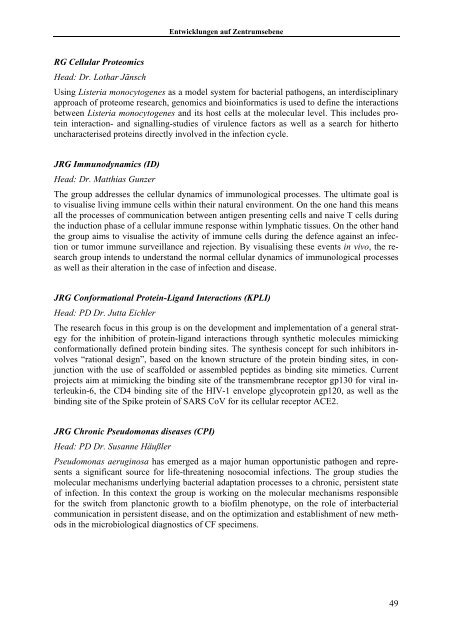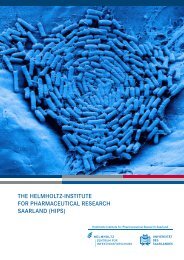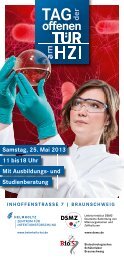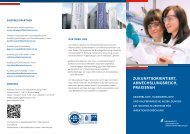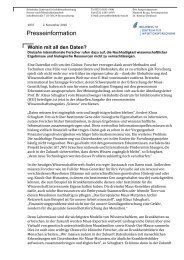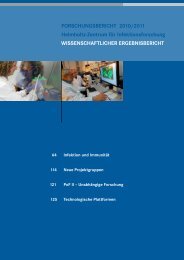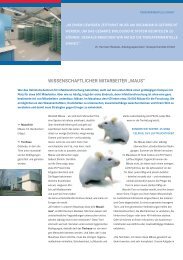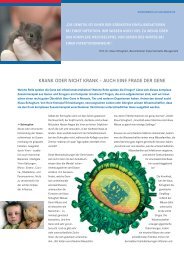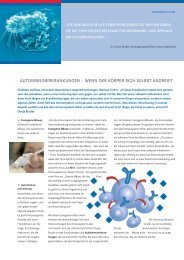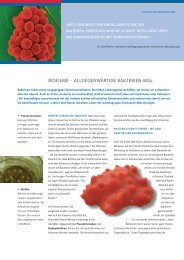FORTSCHRITTSBERICHT JAHR 2006 - Helmholtz-Zentrum für ...
FORTSCHRITTSBERICHT JAHR 2006 - Helmholtz-Zentrum für ...
FORTSCHRITTSBERICHT JAHR 2006 - Helmholtz-Zentrum für ...
Sie wollen auch ein ePaper? Erhöhen Sie die Reichweite Ihrer Titel.
YUMPU macht aus Druck-PDFs automatisch weboptimierte ePaper, die Google liebt.
Entwicklungen auf <strong>Zentrum</strong>sebene<br />
RG Cellular Proteomics<br />
Head: Dr. Lothar Jänsch<br />
Using Listeria monocytogenes as a model system for bacterial pathogens, an interdisciplinary<br />
approach of proteome research, genomics and bioinformatics is used to define the interactions<br />
between Listeria monocytogenes and its host cells at the molecular level. This includes protein<br />
interaction- and signalling-studies of virulence factors as well as a search for hitherto<br />
uncharacterised proteins directly involved in the infection cycle.<br />
JRG Immunodynamics (ID)<br />
Head: Dr. Matthias Gunzer<br />
The group addresses the cellular dynamics of immunological processes. The ultimate goal is<br />
to visualise living immune cells within their natural environment. On the one hand this means<br />
all the processes of communication between antigen presenting cells and naive T cells during<br />
the induction phase of a cellular immune response within lymphatic tissues. On the other hand<br />
the group aims to visualise the activity of immune cells during the defence against an infection<br />
or tumor immune surveillance and rejection. By visualising these events in vivo, the research<br />
group intends to understand the normal cellular dynamics of immunological processes<br />
as well as their alteration in the case of infection and disease.<br />
JRG Conformational Protein-Ligand Interactions (KPLI)<br />
Head: PD Dr. Jutta Eichler<br />
The research focus in this group is on the development and implementation of a general strategy<br />
for the inhibition of protein-ligand interactions through synthetic molecules mimicking<br />
conformationally defined protein binding sites. The synthesis concept for such inhibitors involves<br />
“rational design”, based on the known structure of the protein binding sites, in conjunction<br />
with the use of scaffolded or assembled peptides as binding site mimetics. Current<br />
projects aim at mimicking the binding site of the transmembrane receptor gp130 for viral interleukin-6,<br />
the CD4 binding site of the HIV-1 envelope glycoprotein gp120, as well as the<br />
binding site of the Spike protein of SARS CoV for its cellular receptor ACE2.<br />
JRG Chronic Pseudomonas diseases (CPI)<br />
Head: PD Dr. Susanne Häußler<br />
Pseudomonas aeruginosa has emerged as a major human opportunistic pathogen and represents<br />
a significant source for life-threatening nosocomial infections. The group studies the<br />
molecular mechanisms underlying bacterial adaptation processes to a chronic, persistent state<br />
of infection. In this context the group is working on the molecular mechanisms responsible<br />
for the switch from planctonic growth to a biofilm phenotype, on the role of interbacterial<br />
communication in persistent disease, and on the optimization and establishment of new methods<br />
in the microbiological diagnostics of CF specimens.<br />
49


